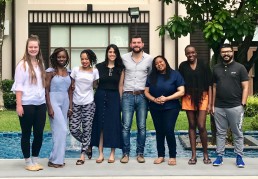
So we collected some data - now what?
Data collection is one of first steps in good impact measurement. But how can we learn from the data we collect?
If you’ve been keeping up with ygap for a while now, you would have heard us talk about our evolving impact measurement practices and learnt a bit about how we manage our impact and what data we collect to make our impact case. Now that we’re slowly building up a depository of data, what can we do with it?
During February this year, we ran our latest round of annual enterprise data collection. Enterprise data is what we collect from our ygap alumni up to two years after they complete their ygap program, and includes indicators such as whether their businesses are still operating, what their annual sales revenue are, how many employees they currently employ and how much funding or investments they have raised. The purpose of collecting this data is to construct a picture of the venture and the changes they’ve experienced since coming out of our program and to analyse how our program and support has played a role in those changes.
Across March and April, each in-country Impact team sat down with the MEL team to consider their data, and using annual sales revenue as a proxy for venture growth, in-country Impact teams reflected on the progress and outcomes that have occurred in the ventures we’ve supported, to evaluate the contribution of the ygap intervention, and determine the areas where we might have fallen short.
Some high-level findings of what we did well include:
- Developing a strong relationship with the venture and being seen by the ventures as being in the trenches with them
- Building confidence of participating entrepreneurs (particularly women and diverse founders) to own their entrepreneurial abilities, and to connect beyond their immediate community
- Brokering meaningful and useful connections for participants, creating linkages in order to address a pain point for the venture, for example, preventing the closure of one of the ventures when we facilitated a partnership with another party who was able to offer assistance with the venture’s cash-flow challenges through investment
- Leveraging the power of alumni and facilitating collaborations between current program participants and past program alumni
“We’re involved in one another’s business! Every step needs peer support, positivity and ability. I’ve found such value spending time with the other participants. [Other entrepreneur] and I would never have met – we were from different cohorts, working in different sectors. Now we can see synergy across our ventures and potential for collaboration” – Past Program Participant
Some areas where we fell short were:
- We didn’t clearly define what kind of entrepreneur and venture were the best fit for our program, and our due-diligence and pre-screening weren’t comprehensive enough
- Our program design and delivery didn’t adequately take into account ventures from regional areas or countries where we had no local contacts to support their development. Additionally, earlier programs that only consisted of the week-long residential component didn’t recognise the value in long-term relationship building of the support phase
- We didn’t manage our relationships with some of our ventures well enough, realising a lack of comprehensive alumni support, especially with ventures we had provided funding to or those with high growth potential.
Our next steps:
A number of recommendations were developed in light of our findings, some of which have already been implemented and others of which will continue to feed our future thinking and program development. To see these recommendations in detail and to read the full report, download here:

Program Learnings Report 2021
Please fill out the below:
Written by ygap’s Monitoring, Evaluation and Learning (MEL) Officer, Hedda Ngan. For more information about our MEL, contact hedda.ngan@ygap.org
